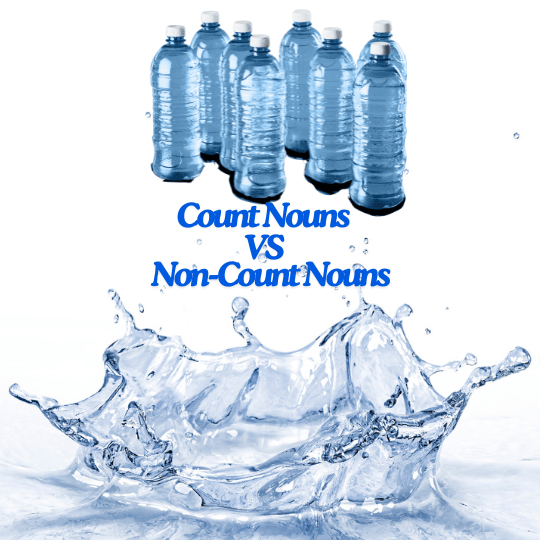Count and non-count nouns are two important categories in English grammar. Understanding the difference between them is crucial for using nouns correctly in sentences.
Count Nouns
Count nouns are nouns that can be separated and counted as individual units. They have a singular and plural form. For example: one book (singular), two books (plural). Count nouns can be made plural.
- Examples: book, dog, chair, apple, student
- You can use “a” or “an” with singular count nouns (a book, an apple).
- Can use “many” or “few”
Non-Count Nouns
Non-count nouns are also called uncountable nouns or mass nouns. These nouns cannot be counted as separate units. Examples are: water, rice, information, happiness, furniture.
Non-count nouns are always singular and don’t have a plural form.
- You can’t use “a” or “an” with non-count nouns.
- Cannot be pluralized in their basic form
- Cannot be used directly with numbers
- Can use “much” or “little”
Common Categories of Non-Count Nouns:
Liquids: water, milk, oil, blood, gasoline
Gases: air, oxygen, nitrogen, smoke
Solids (in bulk): rice, sugar, salt, sand, wood
Abstract concepts: love, happiness, knowledge, wisdom, information
Subjects/Fields of study: mathematics, physics, history, economics
Activities: work, homework, travel, research
Natural phenomena: weather, rain, snow, lightning
Materials: gold, silver, plastic, cotton, wool
Food items (in general): bread, cheese, meat, rice
Collective nouns: furniture, luggage, jewelry, equipment
Key differences Between the Two
Numbers
This is the main difference between the two. You can say “three books” but not “three waters” (unless referring to specific types or containers of water).
Based on that example, if you can separate each item as an individual unit, they are considered count nouns. Books, in this example can easily be identified as singular units.
Bringing them all together gives you three distinct objects that you can count therefore making them count nouns.
Now, for water, as a liquid, is a non-count noun. You can not separate water from itself unless you place them in separate containers. So, we use water as a singular and plural form when it is a non-count noun.
If you separate water into separate containers, like bottles, this is when you can refer to them as individual units but with the understanding that the term “water” refers to “bottle of water” or “container of water” and we are counting water based on the containers and not the actual liquid form.
The Use of Quantifiers
Use “many” or “few” with count nouns, “much” or “little” with mass or non-count nouns. The term many and few can still be separated into units or elements which makes it possible to count the items listed while the use of “much” or “little” gives us a rough approximation of the quantities involved in non-count nouns.
Other quantifiers that we can use for count nouns include: a number of, a third of, none of the, both. For non-count nouns, you can also use these: no, a great deal.
These quantifiers can be used for both types of nouns: all of, most of the, some, plenty of, enough. However, we should still be mindful of the subject-verb agreement when using these.
So, remember, some nouns can be both depending on context. Check the example below.
- “I ate a chicken” (count: whole bird)
- “I ate some chicken” (non-count: meat)
Questions for These Type of Nouns
Based on the quantifiers above, you can ask “How many?” for count nouns and “How much?” for non-count nouns. Try to use the quantifiers listed above in question form so you can use it for both types of nouns.
Understanding this distinction helps with proper grammar usage, especially for articles, plurals, and subject-verb agreement.
My Personal Identification Methods Between the Two
Over the years, I’ve come up with an easy way to differentiate between the two that have helped me in my writing. Here they are:
- Try making it plural. If it sounds odd, it’s likely non-count.
- Try putting “a” before it. If it doesn’t work, it’s probably non-count.
- Consider if you can count it as individual units easily.
Some Exceptions and Tricky Cases
Every rule has an exception. The English language is weird and wacky and there are things you need to consider.
- Some nouns can be both depending on context:
“I drank some water” (non-count)
“We ordered three waters” (count, meaning servings of water)
- Some traditionally non-count nouns can be count in specific contexts:
“She has many anxieties” (referring to specific worries)
- Some nouns change meaning when used as count vs. non-count:
“I need some paper” (non-count, material)
“I need some papers” (count, documents)
- Units of measurement can make non-count nouns countable:
“two cups of sugar”, “three pieces of furniture”
Remember, while these categories are helpful, there can be exceptions and variations across different English dialects. Context is often key in determining whether a noun is being used as count or non-count.
Quiz Time Kids!
Let’s see if you learned anything. Here’s a quiz.
Now just remember, I’m only using information I already know and some additional research on the subject matter. I am in no way a master of the subject. You’d need someone who has an English Major degree or an education degree to give you better information on the subject matter.
Oh, and I had a little help from this site for this article.
Need more help? We’ve got more content from our featured writers here.


1 thought on “Count and Non-Count Nouns”